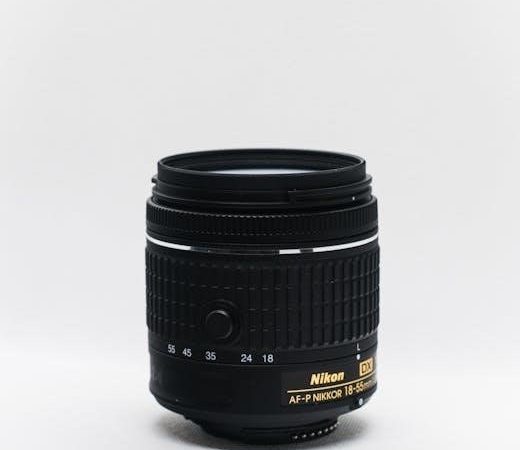The Nikon D3300 DSLR manual is your comprehensive guide to understanding and mastering the camera’s features, settings, and capabilities. It provides detailed instructions for optimal performance, troubleshooting, and tips to enhance your photography experience. Whether you’re a beginner or an advanced user, this manual ensures you unlock the full potential of your Nikon D3300.
1.1 Overview of the Nikon D3300 Camera
The Nikon D3300 is an entry-level DSLR camera designed for beginners and hobbyists. It features a 24.2-megapixel CMOS sensor, 11-point autofocus, and Full HD video recording. The camera is lightweight and user-friendly, making it ideal for those new to DSLR photography. It also includes built-in guide mode, scene modes, and effect modes to enhance creativity. With interchangeable lenses, the D3300 offers versatility for capturing diverse photography styles, from portraits to landscapes.
1.2 Importance of Understanding the Manual
Understanding the Nikon D3300 manual is crucial for unlocking the camera’s full potential. It provides detailed explanations of features, settings, and troubleshooting tips, ensuring optimal performance. The manual helps users customize settings, resolve errors, and master advanced techniques. Whether you’re a beginner or an experienced photographer, the manual serves as a comprehensive guide to enhance your photography skills and make the most of your Nikon D3300.
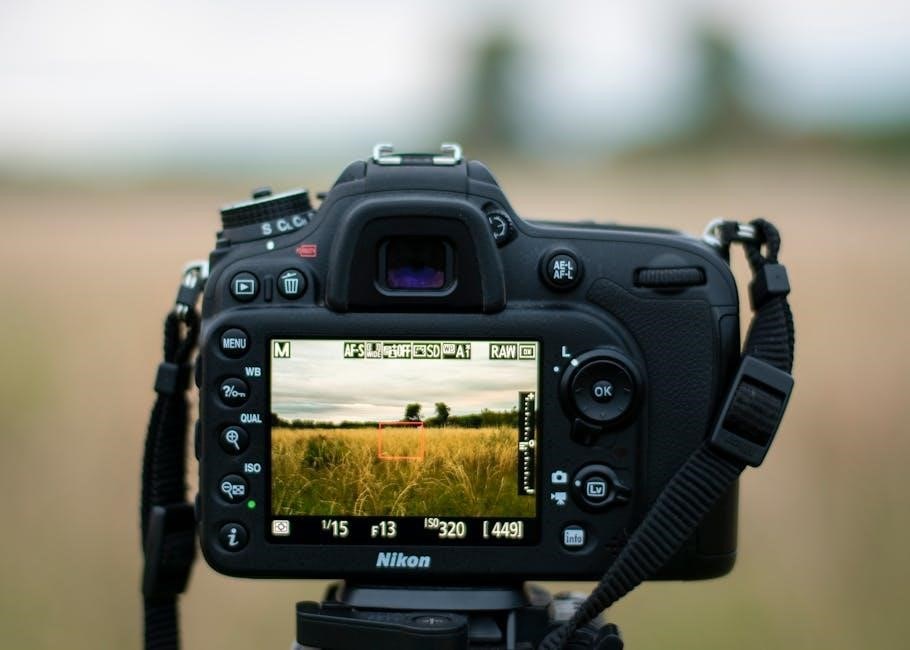
Downloading the Nikon D3300 Manual
Visit Nikon’s official website to download the D3300 manual in PDF format. Both Reference and User Manuals are available for free, ensuring easy access to detailed guidance.
2.1 Where to Find the Official Nikon D3300 Manual
The official Nikon D3300 manual can be found on Nikon’s website, where both the Reference Manual and User Manual are available for free download in PDF format. Additionally, Nikon’s Manual Viewer 2 app allows users to access the manual on mobile devices, ensuring convenience for on-the-go reference. These resources provide comprehensive guidance for optimal camera use and troubleshooting, making them indispensable for both beginners and experienced photographers.
2.2 How to Download the Reference Manual
To download the Nikon D3300 Reference Manual, visit the Nikon website and navigate to the support section. Select your camera model, then choose the Reference Manual from the available downloads. Click the download link to save the PDF file. Ensure you have Adobe Reader installed to view it. This manual provides in-depth technical details and advanced features, ideal for users seeking detailed insights into the camera’s functionality and customization options to enhance their photography skills effectively.
2.3 How to Download the User Manual
Visit the Nikon website and go to the support section. Select the Nikon D3300 from the dropdown menu. Click on the User Manual link, then choose your preferred language. The manual will be available in PDF format for free download. Ensure you have Adobe Reader installed to open the file. This manual is designed to be user-friendly, providing clear instructions for beginners and experienced photographers alike. It covers essential functions, troubleshooting, and basic camera operations to help you get started with your Nikon D3300.

Key Features of the Nikon D3300
The Nikon D3300 features a 24.2MP APS-C sensor, EXPEED 4 processor, and 11-point autofocus system for sharp images. It offers ISO 100-25600 sensitivity and full HD video recording, making it ideal for both still photography and video capture. The camera also includes built-in guide mode, 13 effect modes, and compatibility with Nikon’s F-mount lenses, ensuring versatility for various photography needs.
3.1 Understanding the Camera’s Specifications
The Nikon D3300 boasts a 24.2-megapixel CMOS sensor, capturing vibrant images with excellent detail. Its EXPEED 4 image processor ensures fast performance and efficient noise reduction. The camera features an ISO range of 100-25600, allowing flexibility in various lighting conditions. A 3-inch LCD screen provides a clear view for composing shots. With 11 autofocus points and 5fps continuous shooting, it delivers precise focusing and swift action capture. These specifications make the D3300 a powerful tool for photographers seeking high-quality results.
3.2 Exploring the Effect Modes
The Nikon D3300 offers a variety of Effect modes to enhance your creativity. Options like Night Vision, Pop, and Silhouette apply unique filters to your images and videos. These effects are applied in real-time, allowing you to preview the results before capturing. The camera automatically adjusts settings to achieve the desired artistic look, making it easy to experiment with different styles. Whether you’re shooting stills or video, Effect modes provide a fun and creative way to add personality to your work without complex manual adjustments.
3.3 Navigating the Camera’s Controls
The Nikon D3300 features an intuitive control layout designed for easy navigation. The mode dial on top allows quick access to shooting modes, while buttons for ISO, White Balance, and autofocus modes are strategically placed for quick adjustments. The command dial enables seamless aperture and shutter speed changes in manual modes. Additionally, the navigation buttons and ‘i’ button provide quick access to menu settings, making it simple to adjust camera functions efficiently. This logical design ensures a smooth and enjoyable shooting experience for photographers of all skill levels.

Setting Up Your Nikon D3300
Setting up your Nikon D3300 involves unpacking, attaching the lens, charging the battery, and configuring basic settings. Follow the manual for a seamless startup process.
4.1 Initial Setup and Configuration
Begin by unpacking and inspecting your Nikon D3300. Attach the provided 18-55mm lens, ensuring it clicks securely into place. Charge the battery fully before first use. Insert the SD card, format it via the menu to ensure compatibility. Set the language, time zone, and date in the camera’s setup menu. Familiarize yourself with the mode dial and external controls. Finally, power on the camera and complete any additional prompts to finalize the initial setup process.
4.2 Understanding the Menu System
The Nikon D3300’s menu system is organized into categories for easy navigation. Use the arrow keys to scroll through options like Playback, Shooting, Setup, and Retouch menus. Each category contains settings tailored to specific functions, such as Image Quality, White Balance, and Autofocus modes. The OK button confirms selections, while the Menu button exits. Familiarize yourself with these menus to customize settings and optimize camera performance for various shooting scenarios, ensuring a seamless and personalized photography experience.
4.3 Customizing Your Shooting Settings
Customizing your shooting settings on the Nikon D3300 allows you to tailor the camera to your preferences and shooting style. Adjust settings like Image Quality, White Balance, and ISO to suit your needs; Use the Mode Dial to switch between Auto, P, S, A, and M modes for different levels of control. Access the Shooting Menu to fine-tune options such as Picture Controls and Autofocus settings. Experimenting with these adjustments enables you to optimize image quality and achieve your desired artistic results in various photography scenarios.
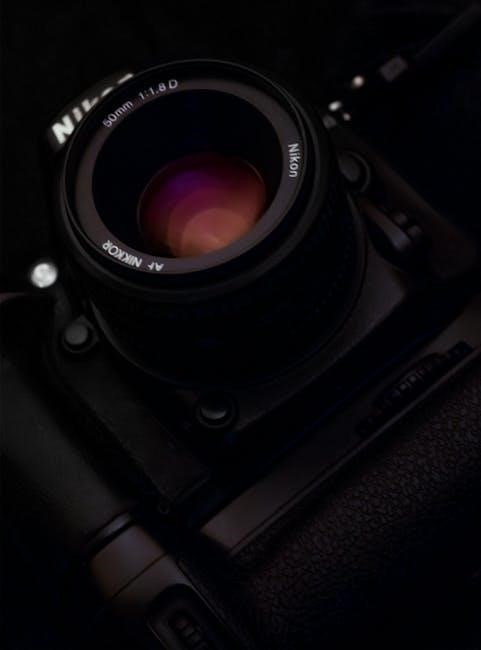
Shooting Modes and Techniques
Explore the Nikon D3300’s shooting modes and techniques to capture stunning images. Auto Mode simplifies photography, while Manual Mode offers full control. Scene Modes optimize settings for specific scenarios, and Continuous Shooting captures dynamic moments. Mastering these modes and techniques enhances your photography skills and creativity.
5.1 Understanding Auto and Manual Modes
Auto Mode simplifies photography by automatically adjusting settings like aperture and shutter speed, ideal for beginners. Manual Mode offers full control, allowing users to customize settings for creative results. The Nikon D3300’s Effect mode provides 13 filters for still images and videos, enhancing your shots. Experiment with both modes to master exposure and achieve your desired effects. This flexibility ensures you can grow from automatic simplicity to manual precision, capturing stunning images effortlessly. Use the Reference Manual or eBooks for deeper insights into these modes and their applications.
5.2 Using Scene Modes for Specific Photography Needs
The Nikon D3300 offers various Scene Modes tailored for specific photography situations, such as Portrait, Landscape, and Night Portrait. These modes automatically optimize settings like aperture, shutter speed, and ISO for the best results. For instance, Portrait mode prioritizes subject focus, while Landscape mode emphasizes sharpness and detail. Using Scene Modes simplifies capturing stunning images without manual adjustments. Experiment with these modes to enhance your photography skills and achieve professional-looking results in different lighting and compositional scenarios. Refer to the manual for detailed guidance on each mode’s application.
5.3 Mastering Continuous Shooting and Burst Mode
Continuous Shooting mode on the Nikon D3300 allows you to capture a sequence of images at a high frame rate, ideal for action or wildlife photography. Burst Mode enhances this by firing shots rapidly with a single press. To activate, select the appropriate mode from the camera menu. The D3300 can shoot up to 5 frames per second, making it great for freezing fast-moving subjects. Use a fast memory card for optimal performance and ensure proper autofocus settings for sharp results. This feature is perfect for capturing dynamic moments effortlessly.

Advanced Features and Customization
Explore the Nikon D3300’s advanced features, including custom settings, white balance adjustments, and ISO configurations. Personalize your camera to suit your unique photography style and needs.
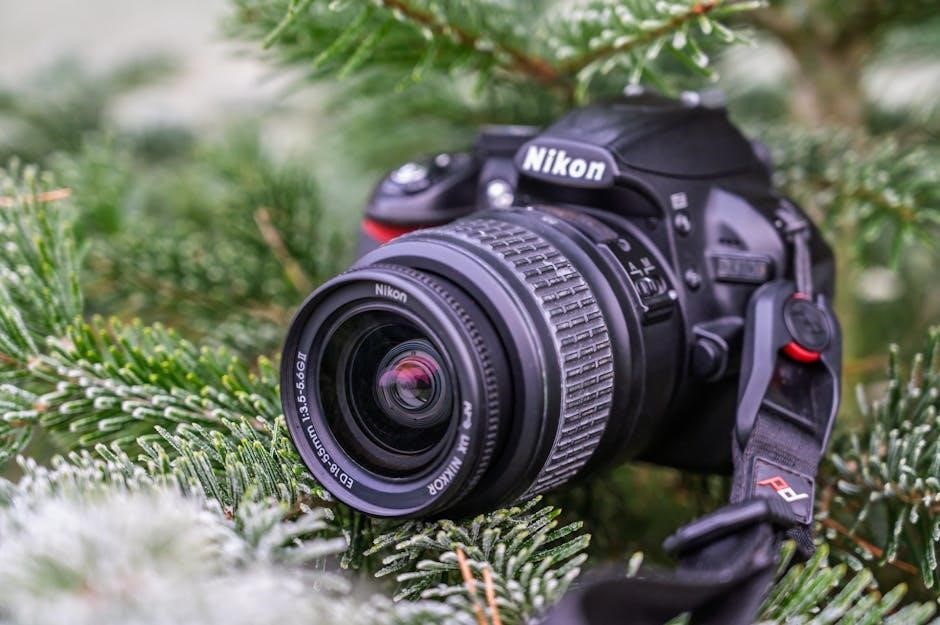
6.1 Using Custom Settings for Personalized Photography
Custom settings on the Nikon D3300 allow you to tailor the camera to your photography style. Adjust autofocus modes, metering options, and white balance to suit specific conditions. Access these settings via the menu system and save your preferences for quick access. This feature is ideal for photographers who want consistent results across different shoots. The manual provides detailed steps to configure and save custom settings, ensuring your camera adapts to your creative vision. Experiment with these options to enhance your photography experience and achieve professional-grade results.
6.2 Understanding White Balance and ISO Settings
White balance ensures accurate colors by adjusting to lighting conditions, while ISO controls sensitivity for low-light photography. Auto modes simplify adjustments, but manual settings offer precision. Lower ISOs (100-400) minimize noise, while higher ISOs (6400-12800) capture images in dim light but may introduce grain. Use white balance presets or custom settings for consistent results. The Nikon D3300 manual guides you through optimizing these settings for various scenarios, helping you achieve professional-grade images with enhanced clarity and color accuracy. Experiment with these controls to refine your photography style and adapt to diverse environments.
6.3 Utilizing Autofocus and Metering Modes
The Nikon D3300 offers advanced autofocus and metering modes to enhance your photography. Autofocus modes include AF-A (auto-servo), AF-S (single-servo), and AF-C (continuous-servo) for precise subject tracking. Metering modes like Matrix, Center-weighted, and Spot ensure accurate exposure. Understanding these modes allows you to capture sharp images and achieve desired lighting effects. Experiment with different settings to master focus and exposure, enabling you to take full control of your camera for stunning results in various shooting conditions.
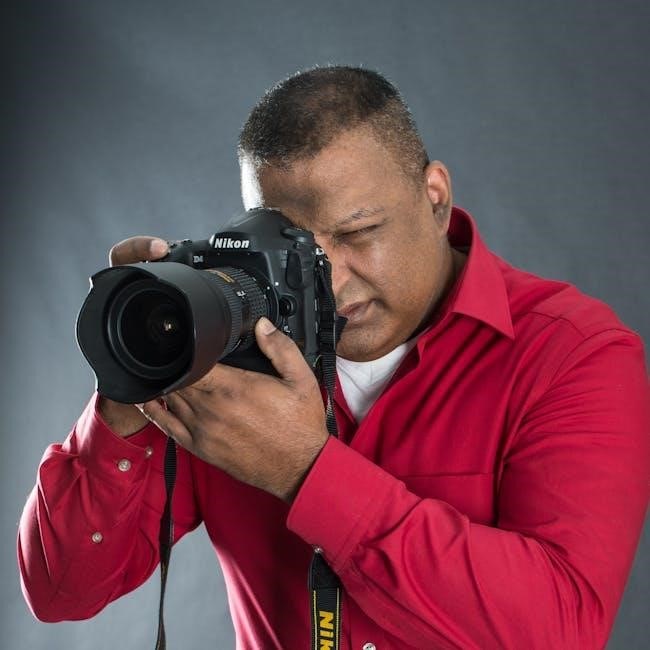
Video Recording with the Nikon D3300
The Nikon D3300 supports HD video recording, offering cinematic quality and creative control. Use Effect modes for unique filters, and apply tips like stabilization and external audio for professional results.
7.1 Basics of Video Recording
To start recording video on your Nikon D3300, switch to Live View mode and press the record button. The camera supports 1080p at 60fps for smooth motion. Use the Mode dial to select manual or automatic settings; Stabilize the camera with a tripod for steady footage. Enable external microphone for better audio. Adjust autofocus settings for sharp video. Review the manual for detailed frame rates and resolution options to enhance your video quality and creative control.
7.2 Using Effect Modes in Video
The Nikon D3300 offers various Effect modes to enhance your video creativity. Options like Night Vision, Miniature Effect, and Silhouette create unique visual styles. These effects can be applied in real-time during recording, allowing you to capture distinctive footage without post-editing. Experiment with different modes to add artistic flair to your videos, ensuring each clip stands out with a personalized touch. This feature is ideal for adding drama or whimsy to your storytelling, making your videos more engaging and memorable.
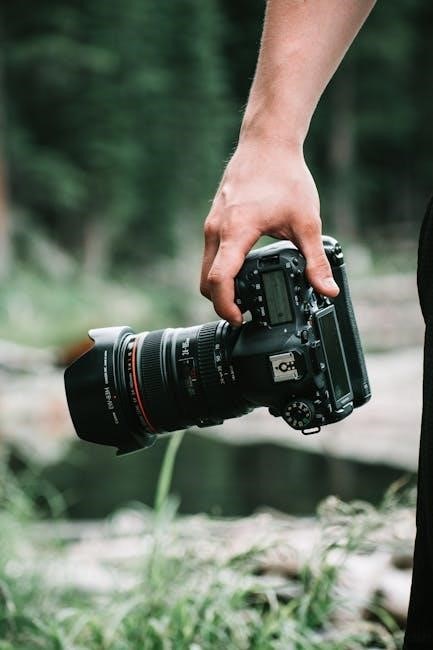
7.3 Tips for Capturing High-Quality Video
To capture high-quality video with your Nikon D3300, ensure proper stabilization using a tripod or handheld rig. Use manual focus for precise control and avoid autofocus hunting. Shoot in well-lit environments or use external lighting for optimal results. Enable external microphone support for clear audio. Experiment with frame rates and resolutions based on your creative needs. Regularly clean your lens and sensor to prevent dust spots. Finally, use a high-capacity memory card to ensure uninterrupted recording. These tips will help you achieve professional-grade video with your D3300.
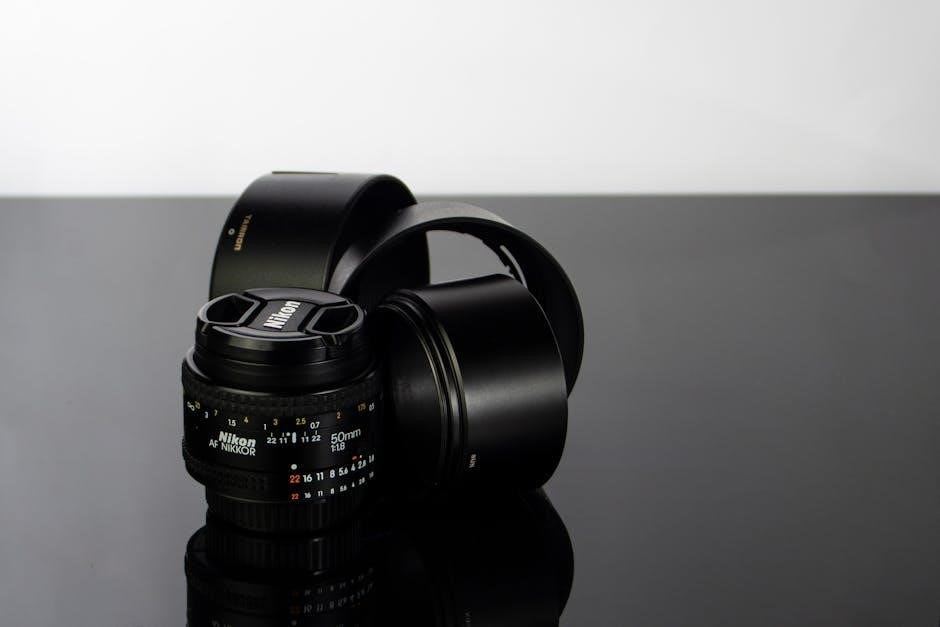
Troubleshooting Common Issues
Resolve error messages, address camera malfunctions, and restore default settings to ensure optimal performance. This section helps you diagnose and fix common problems efficiently.
8.1 Resolving Error Messages
Encounter error messages like “ERR” or issues with card errors? This section guides you through diagnosing and fixing common problems. Learn how to reset settings, clear memory card errors, and address firmware-related issues. Troubleshoot lens compatibility problems and understand error codes. Discover step-by-step solutions to restore functionality, ensuring your Nikon D3300 operates smoothly. From basic resets to advanced troubleshooting, this guide helps you overcome obstacles and maintain peak performance. Regular maintenance and updates can prevent many issues, keeping your camera in optimal condition for capturing stunning images.
8.2 Fixing Common Camera Malfunctions
Experiencing issues like the camera not turning on or the lens not retracting? This section provides solutions for common malfunctions. Learn how to address power issues, lens errors, and LCD display problems. Discover step-by-step fixes for shutter malfunctions and autofocus problems. Understand how to clean the sensor and resolve memory card issues. By following these practical tips, you can identify and repair common faults, ensuring your Nikon D3300 functions properly and continues to deliver high-quality images. Regular maintenance and proper handling can prevent many of these issues from occurring.
8.3 Resetting the Camera to Factory Settings
Resetting your Nikon D3300 to factory settings can resolve persistent issues or prepare the camera for a fresh start. To reset, navigate to the menu, select the “Setup” option, and choose “Reset.” Confirm the action, and the camera will revert to its default settings. Note that this will erase all custom settings, so ensure you have saved any important configurations. This process is ideal for troubleshooting or when transferring ownership. Remember, a factory reset does not fix hardware-related issues but restores software settings to their original state, providing a clean slate for operation;
Additional Resources for Learning
Explore Nikon’s official support, online forums, and recommended eBooks for in-depth guides and tips to enhance your photography skills with the Nikon D3300.
9.1 Recommended eBooks and Guides
Enhance your Nikon D3300 skills with recommended eBooks like Nikon D3300 Experience and The Still Photography Guide to Operation and Image Creation. These guides offer in-depth tutorials, tips, and tricks to master the camera’s features, including Effect modes, custom settings, and advanced techniques. Additionally, the official Nikon D3300 User Manual and Reference Manual are available for download, providing detailed instructions for optimal camera operation. These resources are essential for photographers aiming to unlock the full potential of their Nikon D3300.
9.2 Online Communities and Forums
Join online communities and forums dedicated to Nikon D3300 users to connect with photographers, share tips, and learn from experiences. Platforms like Nikon’s official forums, Nikonians, and photography groups on social media offer valuable insights and troubleshooting advice. Additionally, resources like the Manual Viewer 2 app provide access to official manuals and guides on your mobile device. These communities are a great way to stay updated, solve issues, and enhance your photography skills with the Nikon D3300.
9.3 Nikon’s Official Support and Updates
Nikon offers extensive official support for the D3300, including downloadable manuals, firmware updates, and software tools. Visit their website for the latest updates to ensure optimal camera performance. The Manual Viewer 2 app allows easy access to the D3300 manual on your mobile device. Additionally, Nikon provides customer support through various channels, ensuring you receive assistance whenever needed. Regularly check their official resources to stay informed and make the most of your D3300 photography experience.
The Nikon D3300 DSLR manual provides a comprehensive guide to unlocking your camera’s full potential, ensuring you master its features and enhance your photography skills effectively.
10.1 Summary of Key Takeaways
The Nikon D3300 DSLR manual is designed to help users master the camera’s features, from basic setup to advanced techniques. It covers essential topics like shooting modes, custom settings, and video recording, providing clear guidance for photographers of all skill levels. The manual emphasizes understanding key functions such as autofocus, metering, and ISO settings to capture high-quality images. Additionally, it offers troubleshooting tips and resources for further learning, ensuring users can resolve common issues and continue improving their photography skills effectively.
10.2 Encouragement for Further Exploration
Exploring the Nikon D3300 manual is just the beginning of your photography journey. Encourage yourself to experiment with new techniques, such as exploring effect modes and custom settings, to unlock the camera’s full potential. Regular practice and experimentation will help refine your skills and creativity. Dive into online communities, eBooks, and Nikon’s official resources for additional insights and inspiration. The more you explore, the more you’ll discover the endless possibilities your D3300 offers, enhancing your ability to capture stunning images and tell compelling stories through photography.
